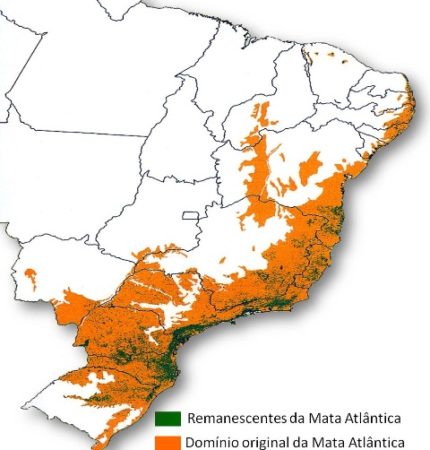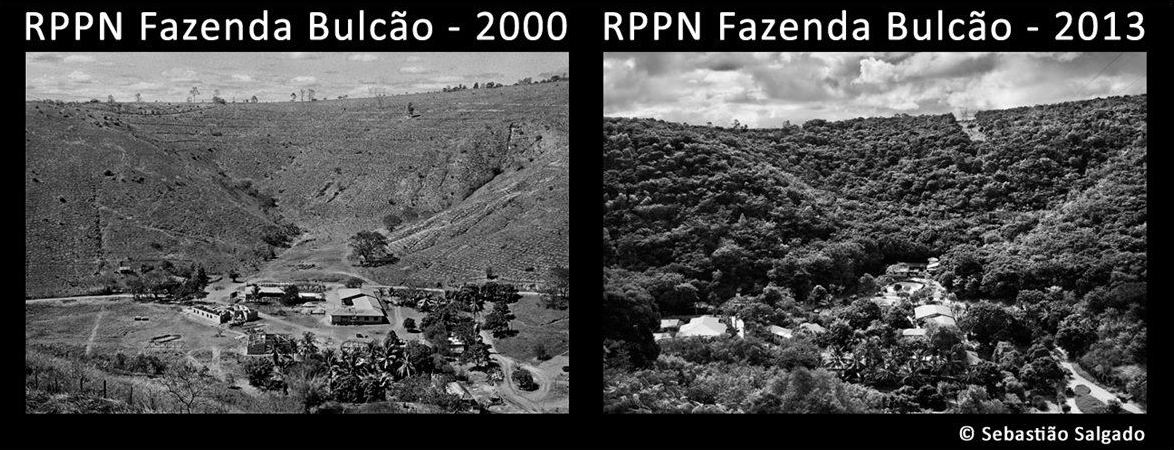Overview
Instituto Terra is a non-profit organization founded in 1999 by Lélia Deluiz Wanick Salgado and the renowned photographer Sebastião Ribeiro Salgado. It is located at the Bulcão Farm in Aimorés, Minas Gerais, and it covers an area of 676 hectares. Since its inception, the institute has dedicated itself to the restoration of degraded stands of Atlantic Forest both on the farm and in the surrounding region. Nurseries have been established to raise seedlings from local sources, and these seedlings are used to replant denuded areas, and also to support smaller reforestation efforts in neighboring communities. In addition to its restoration research and practice, Instituto Terra has also founded an environmental education center that holds classes for ecosystem users and students from nearby urban centers. Ultimately it is hoped that the institute will become a model for future restoration work in the region and a nexus of sustainable development, resource conservation and ecosystem stewardship.
Quick Facts
Project Location:
-19.412027, -42.7136255
Geographic Region:
Latin America
Country or Territory:
Brazil
Biome:
Tropical Forest
Ecosystem:
Tropical Forest - Moist Broadleaf, Tropical Forest - Seasonal Broadleaf
Area being restored:
630 hectares
Project Lead:
Instituto Terra
Organization Type:
Private Landowner
Project Partners:
Instituto Terra plans and implements all restoration activities.
Location
Project Stage:
Implementation
Start Date:
1999-07-11
End Date:
1999-07-11
Planning \ Design:
0
Implementation:
0
Post-Implementation Maintenance:
0
Monitoring & Evaluation:
0
Primary Causes of Degradation
Agriculture & Livestock, Deforestation, Fragmentation, Invasive Species (native or non-native pests, pathogens or plants), Mining & Resource Extraction, Urbanization, Transportation & IndustryDegradation Description
Prior to the colonisation of Brazil in the 16th century, the Atlantic Forest covered over 1,100,000 km2 of the national territory and stretched along its entire southern coast, extending into Argentina and Paraguay. Hunting, wind damage, vine colonisation, fires, the spread of invasive grasses, the exploitation of natural resources such as timber and water, the conversion of forested lands for agricultural use (i.e. cattle ranching and sugarcane and coffee plantations), and the use of pesticides are some of the threats to the Atlantic Forests. The expansion of large cities such as Sao Paolo is also a major cause of deforestation in this region. Indeed, more than 60% of the Brazilian population lives in the Atlantic Forest. Today between 7 and 10% of the original forest remains, and these remaining areas are highly fragmented, further threatening the populations of remaining species. The Máta Atlantica is among the most endangered ecosystems in the world.
Reference Ecosystem Description
The Atlantic Forest biome is considered one of the biggest repositories of biodiversity on the planet. The forest harbors around 2,200 species of birds, mammals, reptiles and amphibians – 5% of the vertebrates on Earth. This includes nearly 200 bird species found nowhere else, and 26 of Brazil’s 77 primate species (including 21 endemic species). The Atlantic Forest is also home to around 20,000 species of plants, representing 8% of the Earth’s plants.
Because of its level of endemism and threat, the Atlantic Forest biome has been selected as a Conservation International Biodiversity Hotspot. The high level of endemism–55% of the tree species and 39% of the mammalian species–is due in part to the fact that the Atlantic Forest is isolated from the major South American forest blocks by the savannas and woodlands of the Cerrado region. Additionally, the forest is distributed over 23 degrees of latitude and encounters variations in altitude and rainfall; it is therefore defined by the diversity of vegetation types and the complexity of the vegetation mosaic. Forty percent of its 20,000 plant species are endemic; 55 of the 250 mammal species are endemic; two-thirds of the primate species are endemic, including the black lion tamarin (Leontopithecus chrysopygus), one of the most highly endangered primates in the world; and 60 of the 190 reptiles species are endemic, 3 of which are threatened with extinction. Other vulnerable species include tapirs (Tapirus terrestris), ocelots (Leopardus pardalis), pumas (Puma concolor) and the locally endangered blue-and-yellow macaw (Ara ararauna) (Global 200, EBA, Centres of Plant Diversity). In all, the forest is home to some 29 critically endangered vertebrate species.
Besides its incredible faunal diversity, the Atlantic Forest also holds the world record for the greatest botanical diversity of tree species in one hectare. Four hundred fifty-four species were counted in a single hectare in southern Bahia, and 476 species were found in one-hectare sample plots in the highland of Espírito Santo. This is more than double the number of tree species found in the entire U.S. eastern seaboard. Some of the tree species in this biome include: jequitibá-rosa (a giant that grows 40 meters high and 4 meters round), pinheiro-do-paraná, cedro, figueiras, ipÁªs, braúna, and pau-brasil. The forest structure of the Atlantic Forest contains multiple canopies that support an extremely rich vegetation mix. This includes an astonishing diversity of ferns, mosses and epiphytes (“air plants” or plants that attach to other plants), including lianas, orchids and bromeliads.
The Atlantic Forest biome has some areas, such as Serra do Mar (1,100 meters high) and Itatiaia (1,600 meters high), that are considered altitude forests because there is constant fog.
Project Goals
– Restore native forest cover on the 630 hectares of Instituto Terra’s property, and surrounding areas.
– Restore ecological processes and participate in the conservation of local biological diversity.
– Develop cost-effective recovery techniques that encourage strong community participation.
– Monitor and assess forest recovery techniques.
– Develop alternative, more sustainable, low impact instruments and techniques of land occupation for local communities.
Monitoring
The project does not have a monitoring plan.
Stakeholders
Instituto Terra has created an environmental education centre, the Center for Environmental Recovery (CERA), in Fazenda Bulcao. Through the centre, Instituto Terra provides courses about issues such as environmental degradation, ecology, forest management, agro ecology, silviculture, permaculture, environmental education, preventing and fighting forest fires, etc.. The strategy is to work with target audiences and key stakeholders such as high school teachers, community leaders, environmentalists, political and civil leaders and, perhaps most important, the rural producers. In 2002, the centre organised 66 courses for 1300 attendees, and the number of classes in 2003 was expected to double.
Description of Project Activities:
Restoration activities are adapted to the four main ecosystem types within the property. Areas covered by aroeira trees were thinned, leaving the aroeira trees at a 6X6 spacing. Tree seedlings from the nursery were planted between the aroeira, and nursery seedlings have been planted in other areas as well. Natural regeneration in these areas is being monitored. Brachiarao grass was dominant in pastures that had been heavily grazed by cattle. The removal of the cattle enabled other herbaceous plants to recover, eventually overshadowing the brachiarao and enabling tree seedlings to grow. The removal of brachiarao grass is an ongoing process in these areas. Areas covered by secondary forest and shrubs are managed in order to promote natural regeneration. In riparian areas, silt is being removed to encourage establishment of native vegetation.
Seeds are collected by specialist collectors and botanical identifiers in the remaining forest fragments in a 150-kilometre radius around Instituto Terra's Bulcão Farm. The nursery provides seedlings for the ongoing restoration at the farm, and it is also able to provide seedlings to local landowners and practitioners of other restoration projects in the region. The nursery is designed to serve as a model for forest restoration and is a means of disseminating new ideas and methodologies.
Ecological Outcomes Achieved
Eliminate existing threats to the ecosystem:
Since November 1999, 175 hectares have been reforested (26% of the total area), and 470,000 native trees have been planted in areas that were previously either completely degraded or used as pastureland. This emerging new forest is rich in biomass and diversity. The animals which had been disappearing are now returning to the area, as they have found a safe refuge at the Instituto Terra farm. One hundred fifty-six species of birds have been identified on the farm, and 6 of these are endangered species - Amazona rhodocorytha (chauá), Amazona vinacea (papagaio de peito roxo), Campephilus robustus (pica pau rei), Procnias nudicollis (araponga), Propyrrhura maracana (maracanã) and Sicalis flaveola (canário da terra verdadeiro). Twenty-one species of mammals have also been seen, two of them in danger of extinction worldwide - Callicebus personatus (sauá ou guigó) and Leopardus pardalis (jaguatirica) - and two others in danger in Brazil - Leopardus tigrinus (gato do mato pequeno) and Puma concolor (sucuarana/puma/onúa parda). The restored forest is now home to over 142 plant species.
Besides biodiversity, water from the Bulcão stream and other springs is beginning to return. A dam that had previously been silted up, along with two other springs, have been recovered thus far. During the dry season, these recovered springs have outflows of around 20 liters/minute. Moreover, we have begun the recovery process of two other springs on the Instituto Terra farm.
In 2001, The Atlantic Forest Conservation Alliance (SOS Mata Atlántica Foundation and Conservation International - Brazil), donated a nursery for 128,000 seedlings to support Instituto Terra's work. In 2002, the Brazilian Ministry of Environment donated an even larger nursery for 522,000 seedlings. In 2003, close to 160 species of Atlantic Forest trees were developed in the nurseries. Instituto Terra has used these seedlings in its own reforestation efforts, and has also provided seedlings for the Aimorés Project and other projects in neighboring municipalities.
Factors limiting recovery of the ecosystem:
Because environmental recovery in degraded areas is still relatively new in Brazil, most of Instituto Terra's work is based on research and is experimental in nature. Therefore, the restoration proceeds more slowly than it would otherwise.
Socio-Economic & Community Outcomes Achieved
Economic vitality and local livelihoods:
An estimated 134,000 Tupi and Guarani people live in the Atlantic Forest in Brazil, Argentina and Paraguay. The ecosystem provides a number of invaluable resources for the communities living within and around it. Vegetation cover provides soil stability, especially on steep slopes, and the biggest extensions of fertile soil in the country are found in the Mata Atlántica. The forest also ensures water supplies for more than 100 million people. Its scenic beauty and biodiversity make the ecosystem a valuable asset for both local communities and ecotourism industries. In all, it is estimated that roughly seventy percent of Brazil's GDP is owed to the resources of this forest.
Key Lessons Learned
In order to develop a landscape-scale restoration programme, the institute has had to integrate grassland, secondary woodland, and aroeira restoration objectives. The programme has been successful to this point and has attracted the attention of other individuals and groups with an interest in Atlantic Forest restoration. In fact, a hydroelectric plant in the region is now using Instituto Terra’s techniques and seedlings in restoring the gallery forest.
Long-Term Management
Environmental education and community outreach are integral components of Instituto Terra’s long-term restoration strategy. In accordance with these goals, the CERA education centre has been established to educate people about local ecology and to encourage the sustainable use of natural resources, the conservation of biodiversity, the effective management of water and soil, and the restoration of degraded forest areas. By disseminating information about agroecological alternatives of production and environmental management to schools, community members and rural producers, Instituto Terra hopes to stimulate critical reflection about the current model of development and aid in the formation of future agricultural, environmental and forest technicians in these rural areas.
Sources and Amounts of Funding
$2,300,000 + USD Since 1998 the Institute has raised more than $2.3 million. Besides individual donors in Brazil and abroad, Instituto Terra is supported by other governments, institutions and companies through donations, cooperation and partnerships. See the Institute’s website for a list of partner organizations.
Other Resources
Instituto Terra
http://www.institutoterra.org/index.htm



